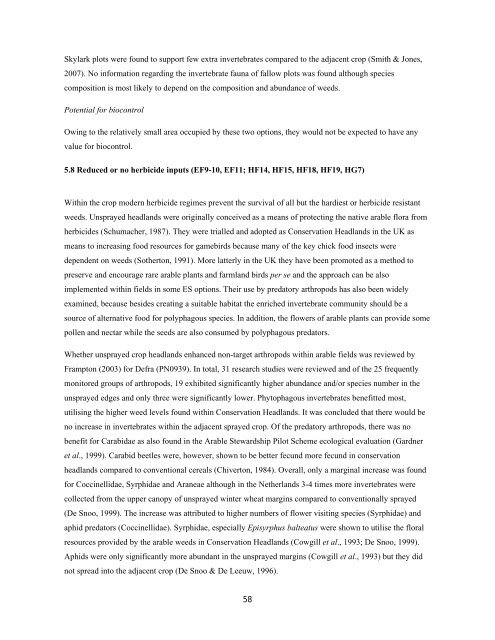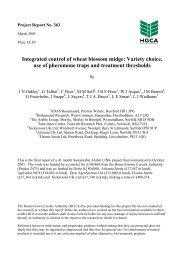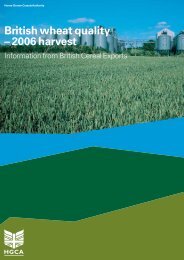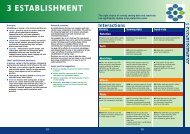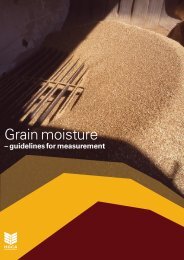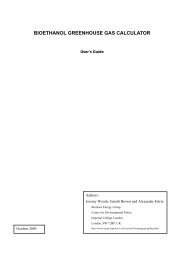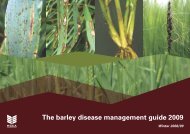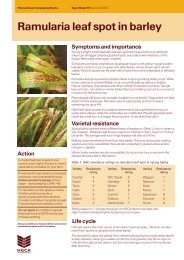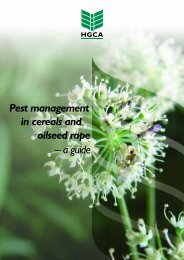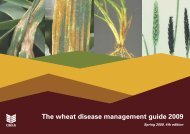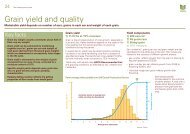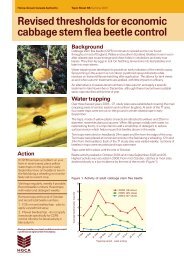5.6 Beetle banks (EF/OF7)This is the only option designed to encourage <strong>natural</strong> <strong>enemies</strong> although in practice farmers were found tochoose this option in order to demark large fields or for game management rather than biocontrol (Thomas,2000). High numbers <strong>of</strong> <strong>natural</strong> <strong>enemies</strong> (Carabidae, Staphylinidae, Araneae) were found overwinteringwithin the ground vegetation <strong>of</strong> hedgerows (Sotherton, 1984, 1985). Raised areas that were less prone towater-logging <strong>and</strong> were preferred by overwintering beetles <strong>and</strong> this led to the development <strong>of</strong> “beetle banks”,raised banks <strong>of</strong> approximately 40 cm height <strong>and</strong> 1.5 m wide covered by tussocky grasses. Initially acombination <strong>of</strong> Dactylis glomerata L. <strong>and</strong> Holcus lanatus L. was recommended (Thomas et al., 1991; 1992),the former was subsequently found to support Carabidae while H. lanatus (Yorkshire fog) was favoured byStaphylinidae (MacLeod et al., 2004). However, D. glomerata (Cock’s foot) was found to rapidly outcompeted H. lanatus whose seed was expensive <strong>and</strong> difficult to obtain (Collins, 1999). In a comparison <strong>of</strong>six grass species, D. glomerata supported the highest densities <strong>of</strong> Carabidae <strong>and</strong> Arrhenatherum elatius L.(False oat grass) those <strong>of</strong> Staphylinidae <strong>and</strong> Araneae, therefore this combination is now recommended(Collins et al., 2003a). Mixes <strong>of</strong> grasses also increase the structural diversity <strong>of</strong> the vegetation <strong>and</strong> therebythat <strong>of</strong> the beneficial <strong>arthropod</strong>s (Baines et al., 1998). Web-building spiders prefer a close structure, althoughlitter depth was also considered an important determinant <strong>of</strong> spider community composition (Bultman &Uetz, 1982). Tussocky grasses provide both a close structure <strong>and</strong> abundance <strong>of</strong> dead leaf material.The value <strong>of</strong> beetle banks as overwintering habitat was not found to deteriorate with successional changes inthe vegetation <strong>and</strong> those over 10 years old had a similar diversity to that <strong>of</strong> a hedge bank (Thomas et al.,2002). Moreover, the abundance <strong>and</strong> diversity <strong>of</strong> beneficial <strong>arthropod</strong>s did not decline with age (MacLeod etal., 2004). Indeed when compared to established hedge banks, beetle banks supported similar densities <strong>of</strong>beneficial <strong>arthropod</strong>s even though <strong>their</strong> numbers fluctuated to a greater extent between years (Collins et al.,2003b; Macleod et al., 2004). The hedgerow was considered to provide additional shelter so bufferingenvironmental conditions, whilst the soil within the hedgebank was also more organic <strong>and</strong> better drainedcompared to the clay soil <strong>of</strong> the beetle bank (Collins et al., 2003b). Overwinter survival is higher where thereis lower soil moisture (Dennis et al., 1994).Potential for biocontrolBased upon the dispersal distances <strong>of</strong> invertebrates overwintering within the banks, the deployment <strong>of</strong> beetlebanks through the centre <strong>of</strong> fields greater than 16 ha was recommended (Thomas et al., 1991). However, animpact on <strong>pests</strong> (cereal aphids) attributed to generalist predators originating from the beetle bank was onlydetected up to 58 m from the beetle bank (Collins et al., 2002).5.7 Skylark <strong>and</strong> fallow plots (EF/OF8; HF13, HF16, HF17, HF20)57
Skylark plots were found to support few extra invertebrates compared to the adjacent crop (Smith & Jones,2007). No information regarding the invertebrate fauna <strong>of</strong> fallow plots was found although speciescomposition is most likely to depend on the composition <strong>and</strong> abundance <strong>of</strong> weeds.Potential for biocontrolOwing to the relatively small area occupied by these two options, they would not be expected to have anyvalue for biocontrol.5.8 Reduced or no herbicide inputs (EF9-10, EF11; HF14, HF15, HF18, HF19, HG7)Within the crop modern herbicide regimes prevent the survival <strong>of</strong> all but the hardiest or herbicide resistantweeds. Unsprayed headl<strong>and</strong>s were originally conceived as a means <strong>of</strong> protecting the native arable flora fromherbicides (Schumacher, 1987). They were trialled <strong>and</strong> adopted as Conservation Headl<strong>and</strong>s in the UK asmeans to increasing food resources for gamebirds because many <strong>of</strong> the key chick food insects weredependent on weeds (Sotherton, 1991). More latterly in the UK they have been promoted as a method topreserve <strong>and</strong> encourage rare arable plants <strong>and</strong> farml<strong>and</strong> birds per se <strong>and</strong> the approach can be alsoimplemented within fields in some ES options. Their use by predatory <strong>arthropod</strong>s has also been widelyexamined, because besides creating a suitable habitat the enriched invertebrate community should be asource <strong>of</strong> alternative food for polyphagous species. In addition, the flowers <strong>of</strong> arable plants can provide somepollen <strong>and</strong> nectar while the seeds are also consumed by polyphagous predators.Whether unsprayed crop headl<strong>and</strong>s enhanced non-target <strong>arthropod</strong>s within arable fields was reviewed byFrampton (2003) for Defra (PN0939). In total, 31 research studies were reviewed <strong>and</strong> <strong>of</strong> the 25 frequentlymonitored groups <strong>of</strong> <strong>arthropod</strong>s, 19 exhibited significantly higher abundance <strong>and</strong>/or species number in theunsprayed edges <strong>and</strong> only three were significantly lower. Phytophagous invertebrates benefitted most,utilising the higher weed levels found within Conservation Headl<strong>and</strong>s. It was concluded that there would beno increase in invertebrates within the adjacent sprayed crop. Of the predatory <strong>arthropod</strong>s, there was nobenefit for Carabidae as also found in the Arable Stewardship Pilot Scheme ecological evaluation (Gardneret al., 1999). Carabid beetles were, however, shown to be better fecund more fecund in conservationheadl<strong>and</strong>s compared to conventional cereals (Chiverton, 1984). Overall, only a marginal increase was foundfor Coccinellidae, Syrphidae <strong>and</strong> Araneae although in the Netherl<strong>and</strong>s 3-4 times more invertebrates werecollected from the upper canopy <strong>of</strong> unsprayed winter wheat margins compared to conventionally sprayed(De Snoo, 1999). The increase was attributed to higher numbers <strong>of</strong> flower visiting species (Syrphidae) <strong>and</strong>aphid predators (Coccinellidae). Syrphidae, especially Episyrphus balteatus were shown to utilise the floralresources provided by the arable weeds in Conservation Headl<strong>and</strong>s (Cowgill et al., 1993; De Snoo, 1999).Aphids were only significantly more abundant in the unsprayed margins (Cowgill et al., 1993) but they didnot spread into the adjacent crop (De Snoo & De Leeuw, 1996).58
- Page 1 and 2:
Research Review No. 64June 2007Pric
- Page 3 and 4:
4.4 Manipulation of natural enemies
- Page 5 and 6:
AbstractPressure to reduce insectic
- Page 7 and 8: 1. IntroductionInsect pest of cerea
- Page 10 and 11: higher in ‘new’ areas.Rape wint
- Page 12 and 13: Potential damage can be caused by t
- Page 14 and 15: loss than the winter generation whi
- Page 16 and 17: 2.12 ‘Wessex’ flea beetle (Psyl
- Page 18 and 19: Cabbage stem flea beetles hatch at
- Page 20 and 21: 4. Review of cereal pest natural en
- Page 23 and 24: midgeContarinia tritici Larva/Pupa
- Page 25 and 26: Cereal ground beetle No infoZabrus
- Page 27 and 28: Myzus persicae Coleoptera Cantharid
- Page 29 and 30: Delia radicum Egg/Larva/Pupa Many C
- Page 31 and 32: Diospilus oleraceus Hymenoptera Bra
- Page 33 and 34: (Biocontrol of Oilseed Rape Insect
- Page 35 and 36: Dolichopodidae (La)Damp areas/Soil/
- Page 37 and 38: 2002). Nevertheless, there have bee
- Page 39 and 40: Therevidae (Stiletto flies) 2 1 2 2
- Page 41 and 42: and further work to examine their d
- Page 43 and 44: ate of repopulation depends on many
- Page 45 and 46: Table 6. Resources provided for nat
- Page 47 and 48: (Crateagus mongyna) supported 209 i
- Page 49 and 50: densities varied enormously between
- Page 51 and 52: in prep). Likewise other studies of
- Page 53 and 54: compared to other cereal crops (Hol
- Page 55 and 56: Wildbird cover can develop a rich u
- Page 57: females select species with appropr
- Page 61 and 62: Carabid abundance was higher 8m int
- Page 63 and 64: 6. Conclusions on potential of Envi
- Page 65 and 66: Where no noxious weeds or volunteer
- Page 67 and 68: conducted in isolation because of t
- Page 69 and 70: 8. ReferencesAdis, J. (1979) Proble
- Page 71 and 72: Chambers, R. J., Sunderland, K. D.,
- Page 73 and 74: Frampton, G. K., Cilgi, T., Fry, G.
- Page 75 and 76: Holland, J. M., Perry, J. N. & Wind
- Page 77 and 78: Meek, B., Loxton, D., Sparks, T., P
- Page 79 and 80: Sotherton, N. W. (1985) The distrib
- Page 81 and 82: oilseed rape across Europe. The BCP
- Page 83 and 84: 2001 More late August drilled winte
- Page 85 and 86: 1998 August drillings emerged rapid
- Page 87 and 88: Oilseed rapeHarvest Review - pest h
- Page 89 and 90: favoured rapid crop development and
- Page 91 and 92: Harvest year 2005. Substantial reco
- Page 93 and 94: Harvest years 2004 and 2003. Limite
- Page 95 and 96: Harvest year 2005. Low numbers of o
- Page 97 and 98: Harvest year 2006. Moderate to high
- Page 99 and 100: Harvest year 2007 (to date). Increa
- Page 101 and 102: Appendix 4. Current and recent comp
- Page 103 and 104: LINK funded projects - current25 Ma
- Page 105 and 106: Appendix 5. List of British researc


